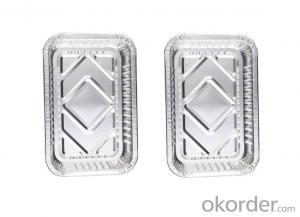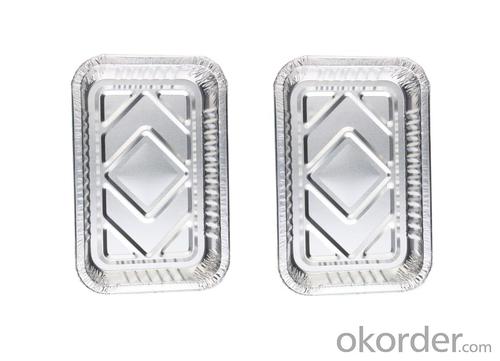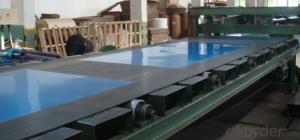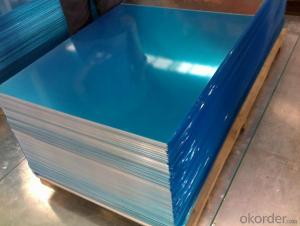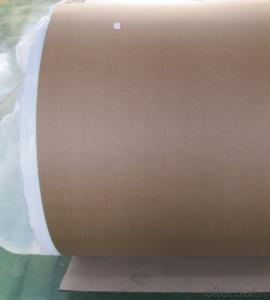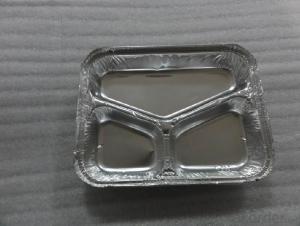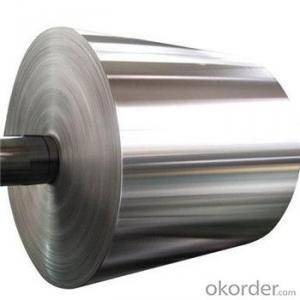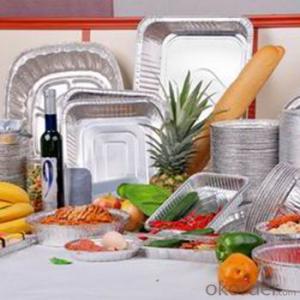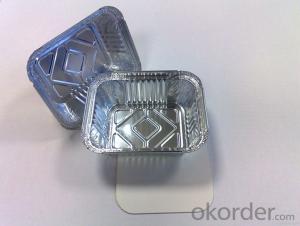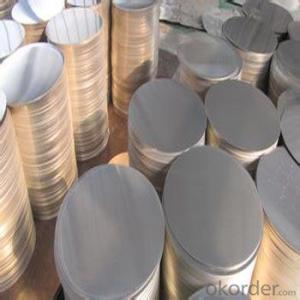Wholesale 1100 Aluminum Sheets for Food Packaging Aluminium Foil Containers
- Loading Port:
- Shanghai
- Payment Terms:
- TT OR LC
- Min Order Qty:
- 5 m.t
- Supply Capability:
- 5000 m.t/month
OKorder Service Pledge
Quality Product, Order Online Tracking, Timely Delivery
OKorder Financial Service
Credit Rating, Credit Services, Credit Purchasing
You Might Also Like
Aluminum foil, an eco-friendly & non-toxic material. The most effective use of the aluminium foil is as a packing material. Mainly used for household purpose, such as storing, packaging, roasting, freezing, heating in food factory, hotel, restaurant, airline etc.
Specifications:
Top Out:160x110mm
In Out:145x95mm
Bottom:125x75mm
Height:35mm
Applications:
Banquet,Cuisine,Roasting,Freezing,Baking,Storage,BBQ.
Advantages:
Environmental protection,recyclable,convenient,safe,healthy,no peculiar smell
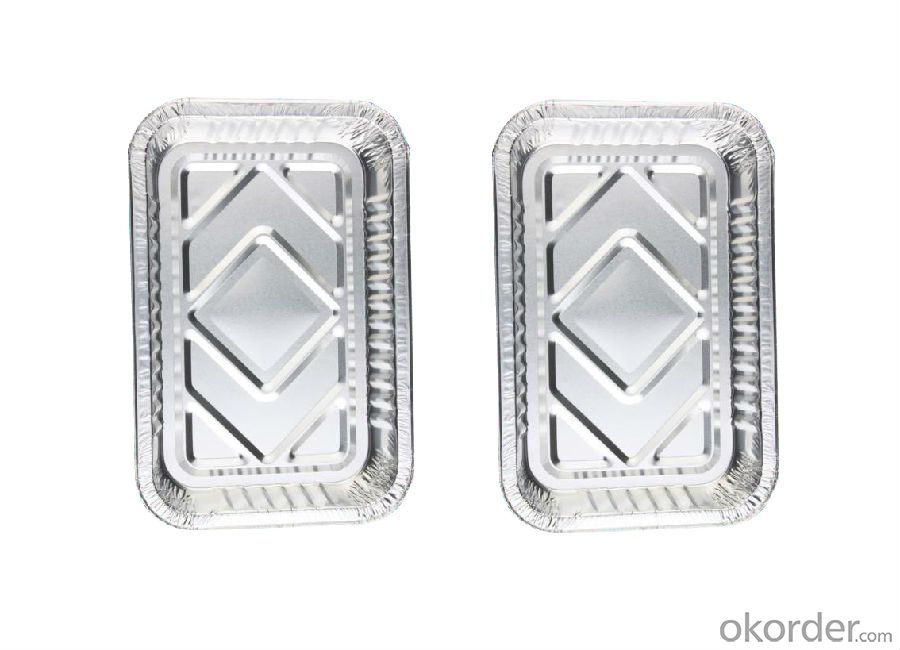
- Q: What are the different types of edges available for aluminum sheets?
- There are several different types of edges available for aluminum sheets, depending on the specific application and desired aesthetic. 1. Straight Edge: This is the most basic type of edge, where the aluminum sheet is cut in a straight line with no additional finishing or shaping. 2. Beveled Edge: A beveled edge is created by cutting the aluminum sheet at an angle, usually 45 degrees, resulting in a chamfered or sloping edge. This type of edge is commonly used for decorative purposes or to reduce sharpness. 3. Rolled Edge: A rolled edge is formed by bending the edge of the aluminum sheet, creating a smooth, rounded edge. This type of edge is often used for safety reasons as it eliminates sharp edges. 4. Hemmed Edge: A hemmed edge is created by folding the edge of the aluminum sheet back on itself, resulting in a double layer of material. This type of edge provides added strength and durability and is commonly used for applications where the edge will be exposed or subjected to wear and tear. 5. Tapered Edge: A tapered edge is formed by gradually reducing the thickness of the aluminum sheet towards the edge. This type of edge is often used in aerospace and automotive industries to reduce weight while maintaining strength. 6. Flanged Edge: A flanged edge is created by bending the edge of the aluminum sheet at a right angle, creating a lip or flange. This type of edge is commonly used for applications where the aluminum sheet needs to be attached or joined with other materials. Overall, the choice of edge type depends on the specific requirements of the project, including functionality, aesthetics, and safety considerations.
- Q: What is the hardness rating of 101 aluminum sheets?
- The hardness of 101 aluminum sheets can vary due to various factors, including alloy composition, heat treatment, and manufacturing processes. Generally, aluminum alloys are considered to have relatively low hardness compared to other metals. While the Rockwell hardness scale is commonly used for measuring metal hardness, it is not typically used for aluminum. Instead, the Brinell or Vickers hardness tests are more commonly employed for aluminum alloys. Without detailed information regarding the alloy composition and specific heat treatment applied to the 101 aluminum sheets, it is challenging to provide an exact hardness rating. Therefore, it is advised to consult the manufacturer or supplier of the specific 101 aluminum sheets to obtain accurate hardness information.
- Q: Is it possible to utilize aluminum sheets in interior design projects?
- <p>Yes, aluminum sheets can be used for interior design purposes. They are lightweight, durable, and resistant to corrosion, making them suitable for various applications such as wall cladding, ceilings, and furniture. Aluminum sheets can also be painted or anodized to achieve different finishes, adding aesthetic appeal to your design. However, it's important to consider the specific requirements of your project, such as load-bearing capacity and thermal insulation, as these properties can vary with different types of aluminum sheets.</p>
- Q: This question asks for an explanation of the various grades of aluminum sheets and the distinctions between them.
- <p>Aluminum sheets are categorized into different grades based on their alloy composition, which affects their properties such as strength, formability, and corrosion resistance. Common grades include 1000 series (99.00% aluminum, soft and malleable), 2000 series (aluminum-copper alloys, strong and heat treatable), 3000 series (aluminum-manganese alloys, good formability), 5000 series (aluminum-magnesium alloys, good strength and corrosion resistance), and 6000 series (aluminum-silicone-magnesium alloys, good strength and extrudability). Each grade has specific applications based on its characteristics, with 1000 series used for general purposes, 2000 series for aircraft structures, 3000 series for decorative applications, 5000 series for marine environments, and 6000 series for structural components.</p>
- Q: Do 101 aluminum sheets require any special maintenance or care?
- 101 aluminum sheets do not require any special maintenance or care. Aluminum is a durable and corrosion-resistant material, so it can withstand various environmental conditions without deteriorating. However, to ensure their longevity and optimal performance, it is recommended to keep them clean from dirt or debris by regularly wiping them with a soft cloth or sponge. Additionally, avoiding abrasive or harsh cleaning agents is advisable to prevent any potential damage to the aluminum sheets. Overall, with minimal attention and care, 101 aluminum sheets can maintain their quality and appearance for an extended period.
- Q: Can 101 aluminum sheets be anodized in different colors?
- Indeed, it is possible to anodize 101 aluminum sheets in various hues. Anodization entails generating an oxide coating on the aluminum's surface, which can then be dyed to attain a plethora of colors. The quantity of sheets, in this instance 101, does not impede the capacity to anodize them in distinct shades. Every sheet can be anodized and dyed separately to produce a distinct and preferred color. Anodization is a versatile procedure that facilitates customization and color diversity, enabling the achievement of diverse tones and tints on each individual aluminum sheet.
- Q: Are aluminum sheets suitable for electronic components?
- Indeed, electronic components can be accommodated with aluminum sheets. Aluminum, a metal that is both lightweight and durable, exhibits exceptional electrical conductivity. It finds frequent application in the fabrication of electronic housings, heat sinks, and circuit boards. Due to its malleability, aluminum sheets can be effortlessly machined, molded, and joined together, rendering them adaptable for a multitude of electronic purposes. Furthermore, aluminum possesses commendable thermal conductivity, enabling efficient heat dissipation, a vital feature for averting overheating in electronic devices.
- Q: Can aluminum sheets be used for chemical reactors?
- Certain applications allow for the use of aluminum sheets in chemical reactors. Aluminum possesses excellent corrosion resistance, rendering it appropriate for diverse chemical reactions. Nevertheless, it is crucial to take into account the nature of the chemicals employed and their potential reactivity with aluminum. In highly acidic or alkaline environments, aluminum's reactivity and susceptibility to corrosion should be duly recognized. Furthermore, specific gases or elevated temperatures may render aluminum unsuitable for reactions. In such instances, alternative materials such as stainless steel or glass-lined reactors might prove more fitting.
- Q: This question asks about the typical duration an aluminum roof sheet can last before it needs to be replaced or repaired.
- <p>The lifespan of aluminum sheets for roofing can vary depending on the quality of the material, installation, and environmental factors. On average, a well-maintained aluminum roof can last between 20 to 50 years. High-quality aluminum roofing materials, when properly installed, can even exceed this range, offering a lifespan of up to 70 years. However, it's important to note that regular inspections and maintenance are crucial to extend the life of any roofing material, including aluminum.</p>
- Q: Can aluminum sheet be anodized?
- Yes, aluminum sheet can be anodized. Anodizing is an electrochemical process that enhances the natural oxide layer on the surface of aluminum, making it thicker, more durable, and better suited for various applications. The process involves immersing the aluminum sheet into an electrolyte solution and passing an electric current through it. This causes oxygen ions to be released from the electrolyte and bond with the aluminum, forming a new layer of aluminum oxide. Anodizing can be used to create a range of colors on the surface of the aluminum sheet, as well as improve its corrosion resistance and provide a better surface for adhesion of paints or coatings.
Send your message to us
Wholesale 1100 Aluminum Sheets for Food Packaging Aluminium Foil Containers
- Loading Port:
- Shanghai
- Payment Terms:
- TT OR LC
- Min Order Qty:
- 5 m.t
- Supply Capability:
- 5000 m.t/month
OKorder Service Pledge
Quality Product, Order Online Tracking, Timely Delivery
OKorder Financial Service
Credit Rating, Credit Services, Credit Purchasing
Similar products
Hot products
Hot Searches
Related keywords
